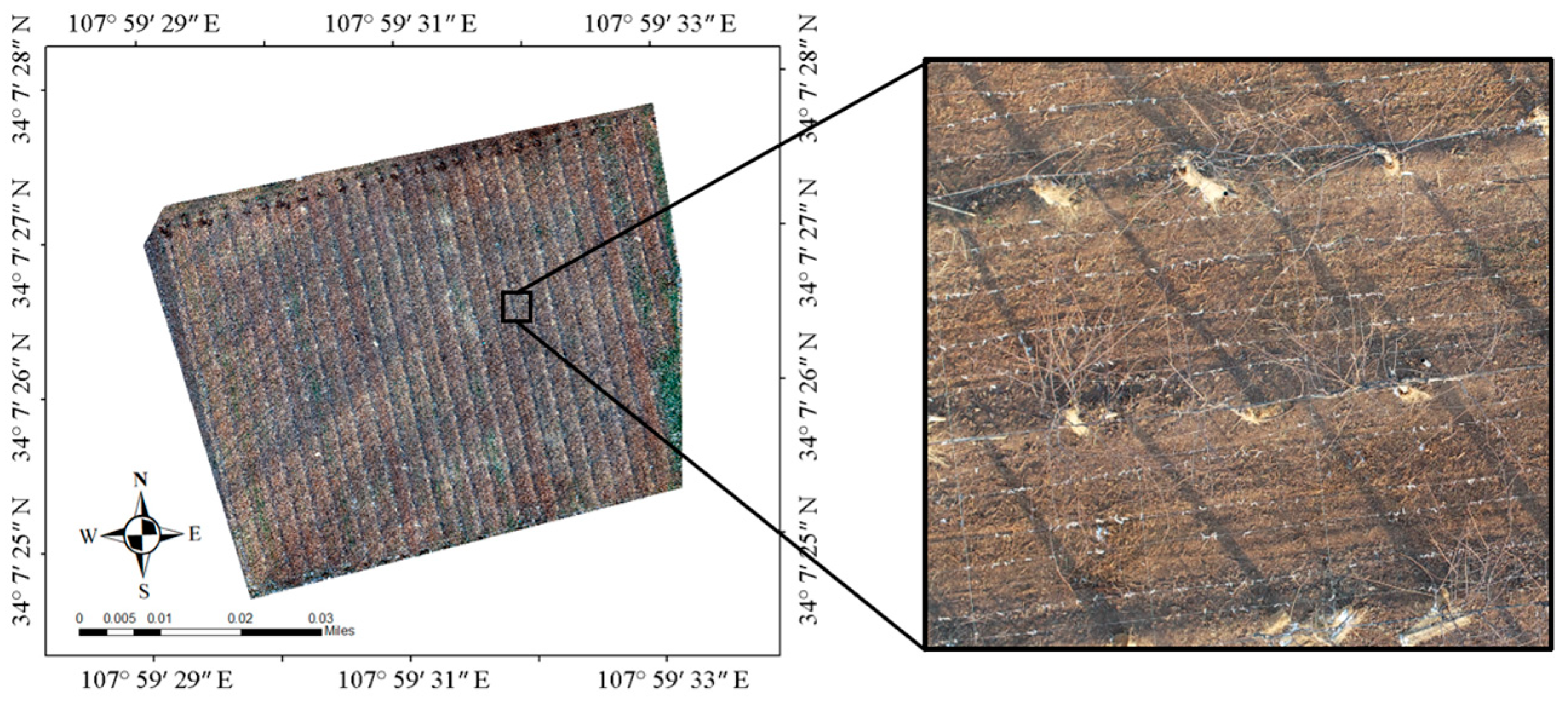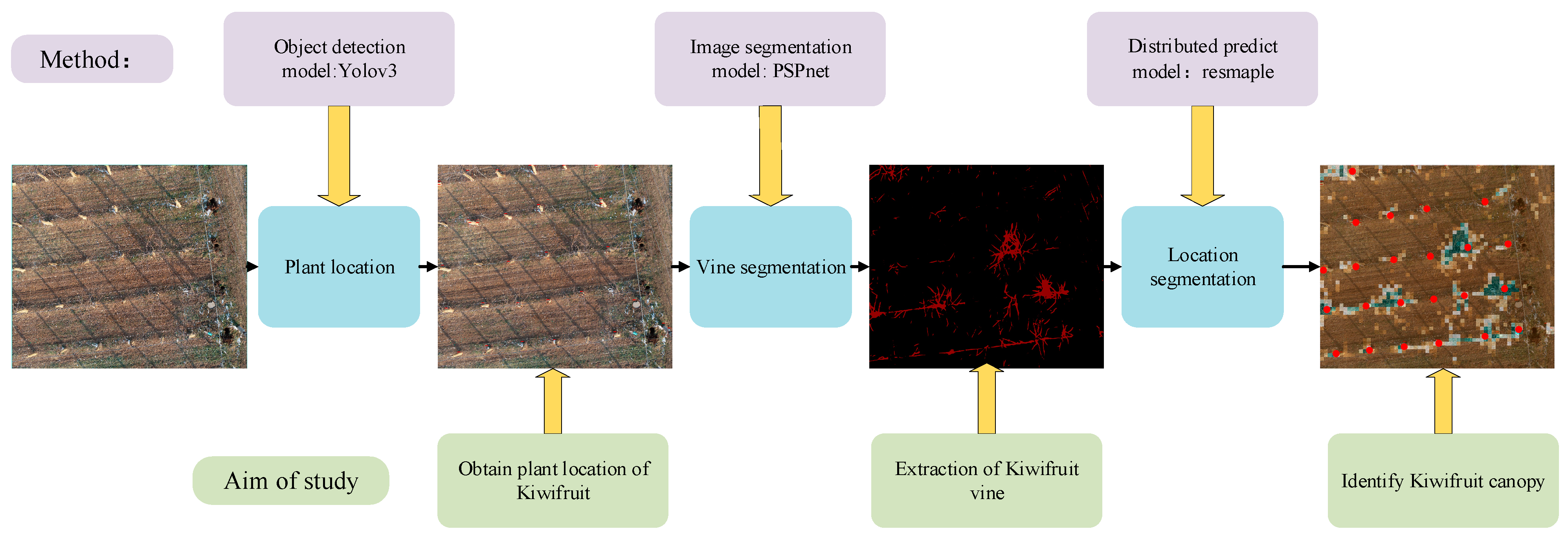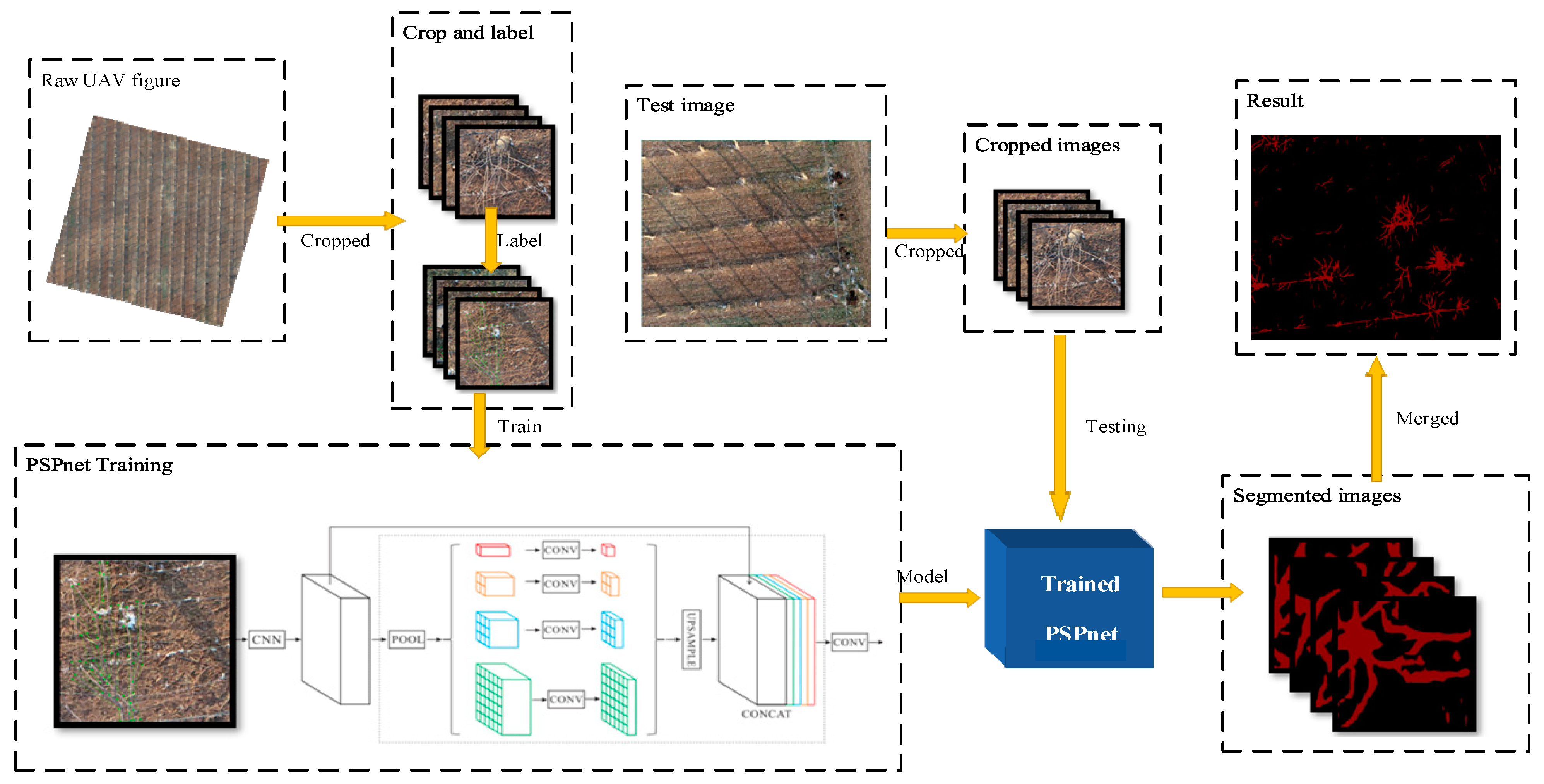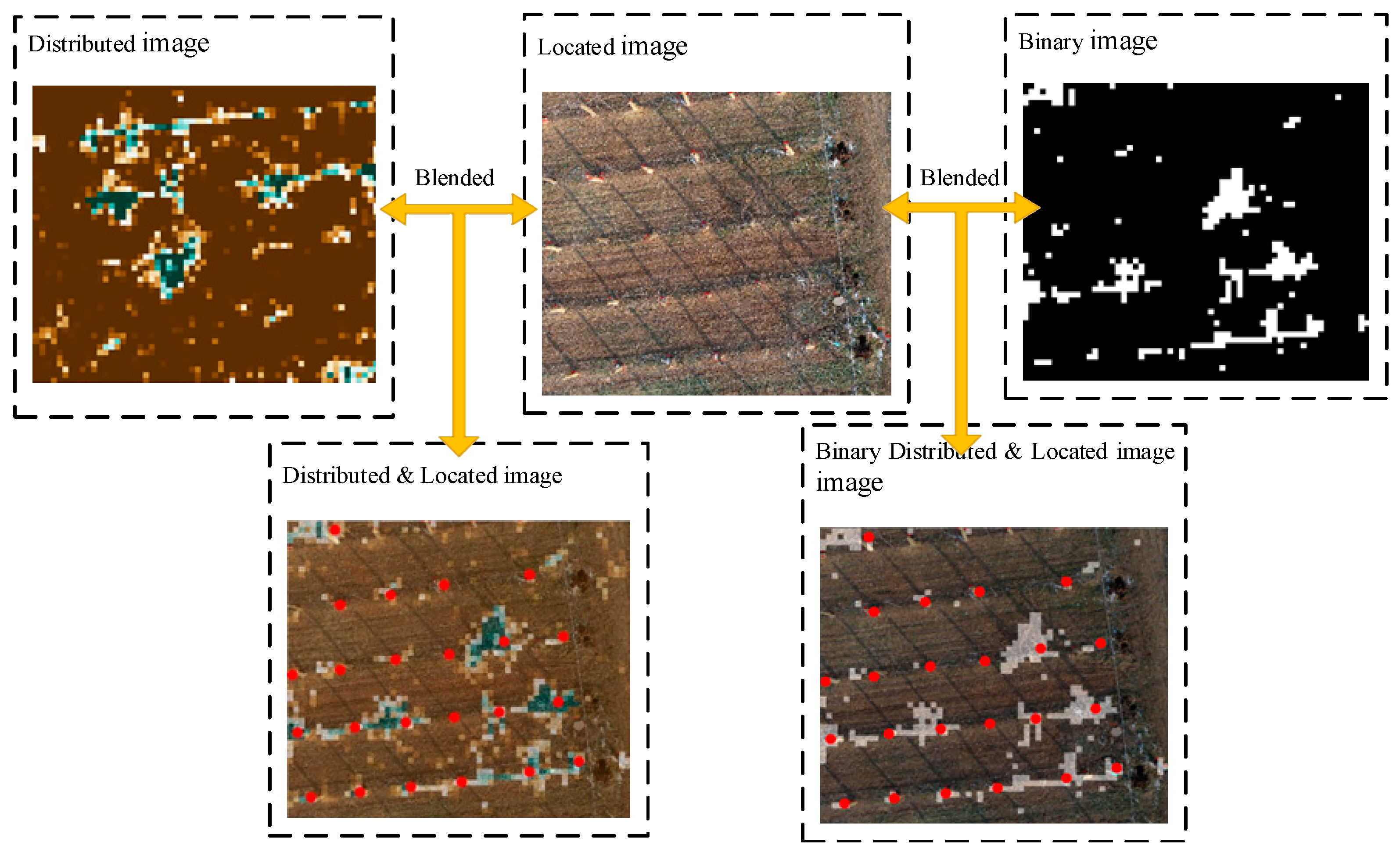Identifying the Branch of Kiwifruit Based on Unmanned Aerial Vehicle (UAV) Images Using Deep Learning Method
Abstract
:1. Introduction
- (1)
- The images were spliced by Pix4D to generate an orthophoto;
- (2)
- The orthophoto image was clipped to the size suitable for network training, and 300 images were selected to make the data set;
- (3)
- Three kinds of classifiers were trained by data set, and the trained classifiers were used to process the image to obtain the segmented image;
- (4)
- Different sampling size S and threshold level T were set to process the segmented image and count the IoU;
- (5)
- According to the change of IoU, the best parameters of S and T were selected to test 40 test images to verify the performance of the model;
- (6)
- Finally, the PLD-M model was formed.
2. Materials and Methods
2.1. Experimental Sites
2.2. Brief Introduction of the PLD-M
2.3. Extraction of the Kiwifruit Vine
2.3.1. Random Forest Image Segmentation
2.3.2. Support Vector Machine Image Segmentation
2.3.3. Deep Semantic Segmentation
2.4. Plant Location and Distribution
2.4.1. Resampling Processing
2.4.2. Coordinate and Resampling
3. Results
3.1. Analysis of the Image Processing Results
3.1.1. Accuracy Evaluation of the RF, SVM, and PSPnet
3.1.2. Advantages of Deep Semantic Segmentation
3.2. Influence of Threshold Parameters on the Accuracy of the Distributed Images
3.3. Model Evaluation
4. Discussion
4.1. Advantages and Limitations of the Model
4.2. Research Significance and Prospect
5. Conclusions
Author Contributions
Funding
Institutional Review Board Statement
Informed Consent Statement
Data Availability Statement
Acknowledgments
Conflicts of Interest
Appendix A
| Methods | T = 1 | T = 2 | T = 3 | T = 4 | T = 5 | T = 6 | T = 7 | T = 8 |
|---|---|---|---|---|---|---|---|---|
| PSPnet | 0.4969 | 0.6192 | 0.6380 | 0.6394 | 0.6292 | 0.6271 | 0.6197 | 0.6126 |
| RF | 0.4742 | 0.4642 | 0.3559 | 0.2531 | 0.2084 | 0.1877 | 0.1764 | 0.1704 |
| SVM | 0.4743 | 0.4604 | 0.4408 | 0.4119 | 0.3800 | 0.3494 | 0.3243 | 0.3056 |
| Methods | T = 1 | T = 2 | T = 3 | T = 4 | T = 5 | T = 6 | T = 7 | T = 8 |
|---|---|---|---|---|---|---|---|---|
| PSPnet | 0.4824 | 0.6152 | 0.6440 | 0.6447 | 0.6311 | 0.6279 | 0.6200 | 0.6172 |
| RF | 0.4658 | 0.4630 | 0.3560 | 0.2463 | 0.2011 | 0.1828 | 0.1720 | 0.1660 |
| SVM | 0.4658 | 0.4561 | 0.4344 | 0.4132 | 0.3752 | 0.3471 | 0.3203 | 0.3006 |
| Methods | T = 1 | T = 2 | T = 3 | T = 4 | T = 5 | T = 6 | T = 7 | T = 8 |
|---|---|---|---|---|---|---|---|---|
| PSPnet | 0.5283 | 0.6341 | 0.6657 | 0.6705 | 0.6640 | 0.6517 | 0.6443 | 0.6370 |
| RF | 0.5136 | 0.5121 | 0.3809 | 0.2562 | 0.2093 | 0.1896 | 0.1792 | 0.1732 |
| SVM | 0.5132 | 0.4992 | 0.4780 | 0.4421 | 0.3988 | 0.3611 | 0.3362 | 0.3155 |
| Methods | T = 1 | T = 2 | T = 3 | T = 4 | T = 5 | T = 6 | T = 7 | T = 8 |
|---|---|---|---|---|---|---|---|---|
| PSPnet | 0.5225 | 0.6287 | 0.6750 | 0.6808 | 0.6751 | 0.6629 | 0.6545 | 0.6435 |
| RF | 0.5135 | 0.5052 | 0.3882 | 0.2570 | 0.2069 | 0.1883 | 0.1775 | 0.1717 |
| SVM | 0.5129 | 0.5011 | 0.4810 | 0.4537 | 0.4096 | 0.3692 | 0.3317 | 0.3135 |
| Methods | T = 1 | T = 2 | T = 3 | T = 4 | T = 5 | T = 6 | T = 7 | T = 8 |
|---|---|---|---|---|---|---|---|---|
| PSPnet | 0.5230 | 0.6402 | 0.6914 | 0.7158 | 0.7061 | 0.6846 | 0.6761 | 0.6658 |
| RF | 0.5130 | 0.5150 | 0.3831 | 0.2528 | 0.2064 | 0.1882 | 0.1788 | 0.1755 |
| SVM | 0.5125 | 0.5014 | 0.4856 | 0.4565 | 0.4150 | 0.3789 | 0.3483 | 0.3310 |
| Methods | T = 1 | T = 2 | T = 3 | T = 4 | T = 5 | T = 6 | T = 7 | T = 8 |
|---|---|---|---|---|---|---|---|---|
| PSPnet | 0.5119 | 0.6318 | 0.6801 | 0.7128 | 0.6946 | 0.6756 | 0.6616 | 0.6550 |
| RF | 0.5051 | 0.5040 | 0.3944 | 0.2530 | 0.2000 | 0.1814 | 0.1722 | 0.1685 |
| SVM | 0.5044 | 0.4920 | 0.4773 | 0.4382 | 0.4012 | 0.3612 | 0.3356 | 0.3123 |
| Methods | T = 1 | T = 2 | T = 3 | T = 4 | T = 5 | T = 6 | T = 7 | T = 8 |
|---|---|---|---|---|---|---|---|---|
| PSPnet | 0.4660 | 0.5905 | 0.6434 | 0.6655 | 0.6713 | 0.6492 | 0.6306 | 0.6229 |
| RF | 0.4581 | 0.4595 | 0.3728 | 0.2396 | 0.1923 | 0.1760 | 0.1681 | 0.1630 |
| SVM | 0.4581 | 0.4541 | 0.4268 | 0.4237 | 0.3992 | 0.3597 | 0.3331 | 0.3074 |
| Methods | T = 1 | T = 2 | T = 3 | T = 4 | T = 5 | T = 6 | T = 7 | T = 8 |
|---|---|---|---|---|---|---|---|---|
| PSPnet | 0.4959 | 0.6269 | 0.7134 | 0.7313 | 0.7506 | 0.7305 | 0.7039 | 0.6844 |
| RF | 0.4891 | 0.4986 | 0.3868 | 0.2474 | 0.1943 | 0.1772 | 0.1697 | 0.1651 |
| SVM | 0.4891 | 0.4795 | 0.4656 | 0.4507 | 0.4171 | 0.3773 | 0.3389 | 0.3139 |
| Methods | T = 1 | T = 2 | T = 3 | T = 4 | T = 5 | T = 6 | T = 7 | T = 8 |
|---|---|---|---|---|---|---|---|---|
| PSPnet | 0.5063 | 0.6228 | 0.6888 | 0.7293 | 0.7432 | 0.7221 | 0.6961 | 0.6732 |
| RF | 0.5042 | 0.5148 | 0.3968 | 0.2512 | 0.1954 | 0.1799 | 0.1719 | 0.1679 |
| SVM | 0.5042 | 0.4941 | 0.4756 | 0.4491 | 0.4073 | 0.3575 | 0.3256 | 0.3050 |
| Methods | T = 1 | T = 2 | T = 3 | T = 4 | T = 5 | T = 6 | T = 7 | T = 8 |
|---|---|---|---|---|---|---|---|---|
| PSPnet | 0.5221 | 0.6311 | 0.6926 | 0.7230 | 0.7248 | 0.7167 | 0.6931 | 0.6863 |
| RF | 0.5173 | 0.5259 | 0.3982 | 0.2539 | 0.2032 | 0.1833 | 0.1774 | 0.1724 |
| SVM | 0.5162 | 0.5000 | 0.4844 | 0.4401 | 0.3870 | 0.3482 | 0.3187 | 0.2949 |
| Methods | T = 1 | T = 2 | T = 3 | T = 4 | T = 5 | T = 6 | T = 7 | T = 8 |
|---|---|---|---|---|---|---|---|---|
| PSPnet | 0.5177 | 0.6180 | 0.6722 | 0.6981 | 0.6938 | 0.6846 | 0.6674 | 0.6590 |
| RF | 0.5150 | 0.5134 | 0.4009 | 0.2536 | 0.2024 | 0.1843 | 0.1771 | 0.1730 |
| SVM | 0.5136 | 0.5093 | 0.4946 | 0.4511 | 0.4084 | 0.3764 | 0.3444 | 0.3192 |
| Methods | T = 1 | T = 2 | T = 3 | T = 4 | T = 5 | T = 6 | T = 7 | T = 8 |
|---|---|---|---|---|---|---|---|---|
| PSPnet | 0.5052 | 0.6204 | 0.6798 | 0.7153 | 0.7309 | 0.6998 | 0.6929 | 0.6794 |
| RF | 0.5022 | 0.5091 | 0.3409 | 0.2266 | 0.1857 | 0.1751 | 0.1681 | 0.1650 |
| SVM | 0.5022 | 0.4958 | 0.4735 | 0.4420 | 0.3875 | 0.3399 | 0.3112 | 0.2901 |
| S = 35 | S = 40 | S = 45 | S = 50 | S = 55 | S = 60 | ||
| T = 1 | 0.4969 | 0.4824 | 0.5283 | 0.5225 | 0.5230 | 0.5119 | |
| T = 2 | 0.6192 | 0.6152 | 0.6341 | 0.6287 | 0.6402 | 0.6318 | |
| T = 3 | 0.6380 | 0.6440 | 0.6657 | 0.6750 | 0.6914 | 0.6801 | |
| T = 4 | 0.6394 | 0.6447 | 0.6705 | 0.6808 | 0.7158 | 0.7128 | |
| T = 5 | 0.6292 | 0.6311 | 0.6640 | 0.6751 | 0.7061 | 0.6946 | |
| T = 6 | 0.6271 | 0.6279 | 0.6517 | 0.6629 | 0.6846 | 0.6756 | |
| T = 7 | 0.6197 | 0.6200 | 0.6443 | 0.6545 | 0.6761 | 0.6616 | |
| T = 8 | 0.6126 | 0.6172 | 0.6370 | 0.6435 | 0.6658 | 0.6550 | |
| S = 65 | S = 70 | S = 75 | S = 80 | S = 85 | S = 90 | ||
| T = 1 | 0.4660 | 0.4959 | 0.5063 | 0.5221 | 0.5177 | 0.5052 | |
| T = 2 | 0.5905 | 0.6269 | 0.6228 | 0.6311 | 0.6180 | 0.6204 | |
| T = 3 | 0.6434 | 0.7134 | 0.6888 | 0.6926 | 0.6722 | 0.6798 | |
| T = 4 | 0.6655 | 0.7313 | 0.7293 | 0.7230 | 0.6981 | 0.7153 | |
| T = 5 | 0.6713 | 0.7506 | 0.7432 | 0.7248 | 0.6938 | 0.7309 | |
| T = 6 | 0.6492 | 0.7305 | 0.7221 | 0.7167 | 0.6846 | 0.6998 | |
| T = 7 | 0.6306 | 0.7039 | 0.6961 | 0.6931 | 0.6674 | 0.6929 | |
| T = 8 | 0.6229 | 0.6844 | 0.6732 | 0.6863 | 0.6590 | 0.6794 | |
| S = 35 | S = 40 | S = 45 | S = 50 | S = 55 | S = 60 | ||
| T = 1 | 0.4742 | 0.4658 | 0.5136 | 0.5135 | 0.5130 | 0.5051 | |
| T = 2 | 0.4642 | 0.4630 | 0.5121 | 0.5052 | 0.5150 | 0.5040 | |
| T = 3 | 0.3559 | 0.3560 | 0.3809 | 0.3882 | 0.3831 | 0.3944 | |
| T = 4 | 0.2531 | 0.2463 | 0.2562 | 0.2570 | 0.2528 | 0.2530 | |
| T = 5 | 0.2084 | 0.2011 | 0.2093 | 0.2069 | 0.2064 | 0.2000 | |
| T = 6 | 0.1877 | 0.1828 | 0.1896 | 0.1883 | 0.1882 | 0.1814 | |
| T = 7 | 0.1764 | 0.1720 | 0.1792 | 0.1775 | 0.1788 | 0.1722 | |
| T = 8 | 0.1704 | 0.1660 | 0.1732 | 0.1717 | 0.1755 | 0.1685 | |
| S = 65 | S = 70 | S = 75 | S = 80 | S = 85 | S = 90 | ||
| T = 1 | 0.4581 | 0.4891 | 0.4891 | 0.5173 | 0.5150 | 0.5022 | |
| T = 2 | 0.4595 | 0.4986 | 0.4986 | 0.5259 | 0.5134 | 0.5091 | |
| T = 3 | 0.3728 | 0.3868 | 0.3868 | 0.3982 | 0.4009 | 0.3409 | |
| T = 4 | 0.2396 | 0.2474 | 0.2474 | 0.2539 | 0.2536 | 0.2266 | |
| T = 5 | 0.1923 | 0.1943 | 0.1943 | 0.2032 | 0.2024 | 0.1857 | |
| T = 6 | 0.1760 | 0.1772 | 0.1772 | 0.1833 | 0.1843 | 0.1751 | |
| T = 7 | 0.1681 | 0.1697 | 0.1697 | 0.1774 | 0.1771 | 0.1681 | |
| T = 8 | 0.1630 | 0.1651 | 0.1651 | 0.1724 | 0.1730 | 0.1650 | |
| S = 35 | S = 40 | S = 45 | S = 50 | S = 55 | S = 60 | ||
| T = 1 | 0.4743 | 0.4658 | 0.5132 | 0.5129 | 0.5125 | 0.5044 | |
| T = 2 | 0.4604 | 0.4561 | 0.4992 | 0.5011 | 0.5014 | 0.4920 | |
| T = 3 | 0.4408 | 0.4344 | 0.4780 | 0.4810 | 0.4856 | 0.4773 | |
| T = 4 | 0.4119 | 0.4132 | 0.4421 | 0.4537 | 0.4565 | 0.4382 | |
| T = 5 | 0.3800 | 0.3752 | 0.3988 | 0.4096 | 0.4150 | 0.4012 | |
| T = 6 | 0.3494 | 0.3471 | 0.3611 | 0.3692 | 0.3789 | 0.3612 | |
| T = 7 | 0.3243 | 0.3203 | 0.3362 | 0.3317 | 0.3483 | 0.3356 | |
| T = 8 | 0.3056 | 0.3006 | 0.3155 | 0.3135 | 0.3310 | 0.3123 | |
| S = 65 | S = 70 | S = 75 | S = 80 | S = 85 | S = 90 | ||
| T = 1 | 0.4581 | 0.4891 | 0.5042 | 0.5162 | 0.5136 | 0.5022 | |
| T = 2 | 0.4541 | 0.4795 | 0.4941 | 0.5000 | 0.5093 | 0.4958 | |
| T = 3 | 0.4268 | 0.4656 | 0.4756 | 0.4844 | 0.4946 | 0.4735 | |
| T = 4 | 0.4237 | 0.4507 | 0.4491 | 0.4401 | 0.4511 | 0.4420 | |
| T = 5 | 0.3992 | 0.4171 | 0.4073 | 0.3870 | 0.4084 | 0.3875 | |
| T = 6 | 0.3597 | 0.3773 | 0.3575 | 0.3482 | 0.3764 | 0.3399 | |
| T = 7 | 0.3331 | 0.3389 | 0.3256 | 0.3187 | 0.3444 | 0.3112 | |
| T = 8 | 0.3074 | 0.3139 | 0.3050 | 0.2949 | 0.3192 | 0.2901 | |
References
- Guo, X. Application and development prospect of 3S technology in precision agriculture. Agric. Technol. 2020, 40, 41–43. [Google Scholar]
- Shahzad, A.; Arfeen, Z.A.; Khan, M.A.; Ahmed, T.K.; Tauqeer, A. SLM-OJ: Surrogate Learning Mechanism during Outbreak Juncture. Int. J. Mod. Trends Sci. Technol. 2020, 6, 162–167. [Google Scholar]
- Varela, S.; Dhodda, P.R.; Hsu, W.H.; Prasad, P.V.V.; Assefa, Y.; Peralta, N.R.; Griffin, T.; Sharda, A.; Ferguson, A.; Ciampitti, I.A. Early-Season Stand Count Determination in Corn via Integration of Imagery from Unmanned Aerial Systems (UAS) and Supervised Learning Techniques. Remote Sens. 2018, 10, 343. [Google Scholar] [CrossRef] [Green Version]
- Goldbergs, G.; Maier, S.W.; Levick, S.R.; Edwards, A. Efficiency of Individual Tree Detection Approaches Based on Light-Weight and Low-Cost UAS Imagery in Australian Savannas. Remote Sens. 2018, 10, 161. [Google Scholar] [CrossRef] [Green Version]
- Mu, Y.; Fujii, Y.; Takata, D.; Zheng, B.Y.; Noshita, K.; Honda, K.; Ninomiya, S.; Guo, W. Characterization of peach tree crown by using high-resolution images from anunmanned aerial vehicle. Hortic. Res. 2018, 5, 74. [Google Scholar] [CrossRef] [PubMed] [Green Version]
- Panagiotidis, D.; Abdollahnejad, A.; Surovy, P.; Chiteculo, V. Determining tree height and crown diameter from high-resolution UAV imagery. Int. J. Remote Sens. 2017, 38, 2392–2410. [Google Scholar] [CrossRef]
- Csillik, O.; Cherbini, J.; Johnson, R.; Lyons, A.; Kelly, M. Identification of citrus trees from unmanned aerial vehicle imagery using convolutional neural networks. Drones 2018, 2, 39. [Google Scholar] [CrossRef] [Green Version]
- Ampatzidis, Y.; Partel, V. UAV-Based High Throughput Phenotyping in Citrus Utilizing Multispectral Imaging and Artificial Intelligence. Remote Sens. 2019, 11, 410. [Google Scholar] [CrossRef] [Green Version]
- Wu, J.; Yang, G.; Yang, H.; Zhu, Y.; Li, Z.; Lei, L.; Zhao, C. Extracting apple tree crown information from remote imagery using deep learning. Comput. Electron. Agric. 2020, 174, 105504. [Google Scholar] [CrossRef]
- Redmon, J.; Farhadi, A. YOLOv3: An Incremental Improvement. arXiv 2018, arXiv:1804.02767. [Google Scholar]
- Redmon, J.; Farhadi, A. YOLO9000: Better, Faster, Stronger. In Proceedings of the IEEE Conference on Computer Vision and Pattern Recognition, Honolulu, HI, USA, 21–26 July 2017; pp. 6517–6525. [Google Scholar]
- Luo, Z.; Yu, H.; Zhang, Y. Pine Cone Detection Using Boundary Equilibrium Generative Adversarial Networks and Improved YOLOv3 Model. Sensors 2020, 20, 4430. [Google Scholar] [CrossRef] [PubMed]
- Gai, R.; Chen, N.; Yuan, H. A detection algorithm for cherry fruits based on the improved YOLO-v4 model. Neural Comput. Appl. 2021, 5, 1–12. [Google Scholar]
- Tian, Y.; Yang, G.; Wang, Z.; Wang, H.; Li, E.; Liang, Z. Apple detection during different growth stages in orchards using the improved YOLO-V3 model. Comput. Electron. Agric. 2019, 157, 417–426. [Google Scholar] [CrossRef]
- Zhao, H.; Shi, J.; Qi, X.; Wang, X.; Jia, J. Pyramid Scene Parsing Network. In Proceedings of the IEEE Conference on Computer Vision and Pattern Recognition, Honolulu, HI, USA, 21–26 July 2017. [Google Scholar]
- Sun, Z.Y.; Chen, Y.J.; Yang, L.; Yang, L.; Tang, G.L.; Yuan, S.X.; Lin, Z.W. Low altitude remote sensing of light and small UAV and its application in ecology. J. Appl. Ecol. 2017, 28, 528–536. [Google Scholar]
- Han, Y.J.; Ding, N.; Feng, H.K.; Zhang, C.L. Remote Sensing Estimation of Nitrogen Content in Winter Wheat Leaves Based on Random Forest Algorithm. Mod. Agric. Sci. Technol. 2019, 13, 5. [Google Scholar]
- Zhou, Z.; Sa, J.M.; Fan, Y.X.; Shuai, C.; Gao, S. Remote Sensing Land Usage Classification and Landscape Pattern Analysis Based on Random Forest. Comput. Syst. Appl. 2020, 29, 44–52. [Google Scholar]
- Cortes, C.; Vapnik, V. Support-vector networks. Mach. Learn. 1995, 20, 273–297. [Google Scholar] [CrossRef]
- Ashraf, S.; Ahmed, T. Machine Learning Shrewd Approach for an Imbalanced Dataset Conversion Samples. J. Eng. Technol. 2020, 11, 1. [Google Scholar]
- Kaur, P.; Pannu, H.S.; Malhi, A.K. Plant disease recognition using fractional-order Zernike moments and SVM classifier. Neural Comput. Appl. 2019, 31, 8749–8768. [Google Scholar] [CrossRef]
- Mia, M.R.; Chhoton, A.C.; Mozumder, M.H.; Hossain, S.A.; Hossan, A. An Approach for Mango Disease Recognition using K-Means Clustering and SVM Classifier. In Proceedings of the 8th International Conference System Modeling and Advancement in Research Trends (SMART), Moradabad, India, 22–23 November 2019. [Google Scholar]
- Sannakki, S.S.; Rajpurohit, V.S.; Nargund, V.B. SVM-DSD: SVM Based Diagnostic System for the Detection of Pomegranate Leaf Diseases. In Proceedings of the Advances in Intelligent Systems and Computing; Springer Science and Business Media LLC: Berlin/Heidelberg, Germany, 2013; Volume 174, pp. 715–720. [Google Scholar] [CrossRef]
- He, K.; Zhang, X.; Ren, S.; Sun, J. Deep residual learning for image recognition. In Proceedings of the IEEE Conference on Computer Vision and Pattern Recognition (CVPR), Las Vegas, NV, USA, 27–30 June 2016; Volume 6, pp. 770–778. [Google Scholar]
- Lang, Q.; Zhiyong, Z.; Longsheng, C.; Hong, S.; Minzan, L.; Li, L.; Junyong, M. Detection of Chlorophyll Content in Maize Canopy from UAV Imagery. IFAC Pap. 2019, 52, 330–335. [Google Scholar] [CrossRef]
- Apolo-Apolo, O.E.; Martínez-Guanter, J.; Egea, G.; Raja, P.; Pérez-Ruiz, M. Deep learning techniques for estimation of the yield and size of citrus fruits using a UAV. Eur. J. Agron. 2020, 115, 126030. [Google Scholar] [CrossRef]
- Modica, G.; Messina, G.; Luca, G.D.; Fiozzo, V.; Praticò, S. Monitoring the vegetation vigor in heterogeneous citrus and olive orchards. A multiscale object-based approach to extract trees’ crowns from UAV multispectral imagery. Comput. Electron. Agric. 2020, 175, 105500. [Google Scholar] [CrossRef]
- Osco, L.P.; Nogueira, K.; Ramos, A.P.; Pinheiro, M.M.; Furuya, D.E.; Gonçalves, W.N.; de Castro Jorge, L.A.; Junior, J.M.; dos Santos, J.A. Semantic segmentation of citrus-orchard using deep neural networks and multispectral UAV-based imagery. Precis. Agric. 2021, 4, 1–18. [Google Scholar]
- Fang, J.; Pan, F.J.; Lan, Y.B.; Lu, L.Q.; Cao, D.L.; Yang, D.J.; Wen, Y.T. Wheat lodging area extraction using UAV visible light remote sensing and feature fusion. Trans. Chin. Soc. Agric. Eng. 2021, 37, 73–80. [Google Scholar]
- Song, Z.; Zhang, Z.; Yang, S.; Ding, D.; Ning, J. Identifying sunflower lodging based on image fusion and deep semantic segmentation with UAV remote sensing imaging. Comput. Electron. Agric. 2020, 179, 105812. [Google Scholar] [CrossRef]












| Route Parameters | Detailed Data |
|---|---|
| flight altitude | 20 m |
| Heading/sideward overlap | 80% |
| Image size | 5472 × 3648 |
| Image channel | RGB |
| Imaging band | R (700 mm) G (546.1 mm) B (435.8 mm) |
| Device | Version |
|---|---|
| Programming framework | pytorch1.7.1 |
| Programing language | Python3.6.10 |
| GPU | NVIDIA-GeForce RTX3080s-OC-10GB |
| CPU | Inter-Xeon E5-2600-8-core processor |
| Hyper Parameter | Value |
|---|---|
| Epoch | 100 |
| Batch_size | 8, 4 |
| Learning_rate | , |
| Loss_function | cross entropy loss |
| Resample Area Color | Classes |
|---|---|
| Dark green | Core area |
| Green | Coverage area |
| White | Transition area |
| Brown | Naked land |
| Method | mAP | SNR |
|---|---|---|
| RF | 75.26% | 7.2498 |
| SVM | 85.8% | 10.5154 |
| PSPnet | 71.2% | 12.9523 |
| Threshold Level: T | 1 | 2 | 3 | 4 | 5 | 6 | 7 | 8 |
|---|---|---|---|---|---|---|---|---|
| Threshold | 0.88 | 0.77 | 0.66 | 0.55 | 0.44 | 0.33 | 0.22 | 0.11 |
Publisher’s Note: MDPI stays neutral with regard to jurisdictional claims in published maps and institutional affiliations. |
© 2021 by the authors. Licensee MDPI, Basel, Switzerland. This article is an open access article distributed under the terms and conditions of the Creative Commons Attribution (CC BY) license (https://creativecommons.org/licenses/by/4.0/).
Share and Cite
Niu, Z.; Deng, J.; Zhang, X.; Zhang, J.; Pan, S.; Mu, H. Identifying the Branch of Kiwifruit Based on Unmanned Aerial Vehicle (UAV) Images Using Deep Learning Method. Sensors 2021, 21, 4442. https://doi.org/10.3390/s21134442
Niu Z, Deng J, Zhang X, Zhang J, Pan S, Mu H. Identifying the Branch of Kiwifruit Based on Unmanned Aerial Vehicle (UAV) Images Using Deep Learning Method. Sensors. 2021; 21(13):4442. https://doi.org/10.3390/s21134442
Chicago/Turabian StyleNiu, Zijie, Juntao Deng, Xu Zhang, Jun Zhang, Shijia Pan, and Haotian Mu. 2021. "Identifying the Branch of Kiwifruit Based on Unmanned Aerial Vehicle (UAV) Images Using Deep Learning Method" Sensors 21, no. 13: 4442. https://doi.org/10.3390/s21134442
APA StyleNiu, Z., Deng, J., Zhang, X., Zhang, J., Pan, S., & Mu, H. (2021). Identifying the Branch of Kiwifruit Based on Unmanned Aerial Vehicle (UAV) Images Using Deep Learning Method. Sensors, 21(13), 4442. https://doi.org/10.3390/s21134442







